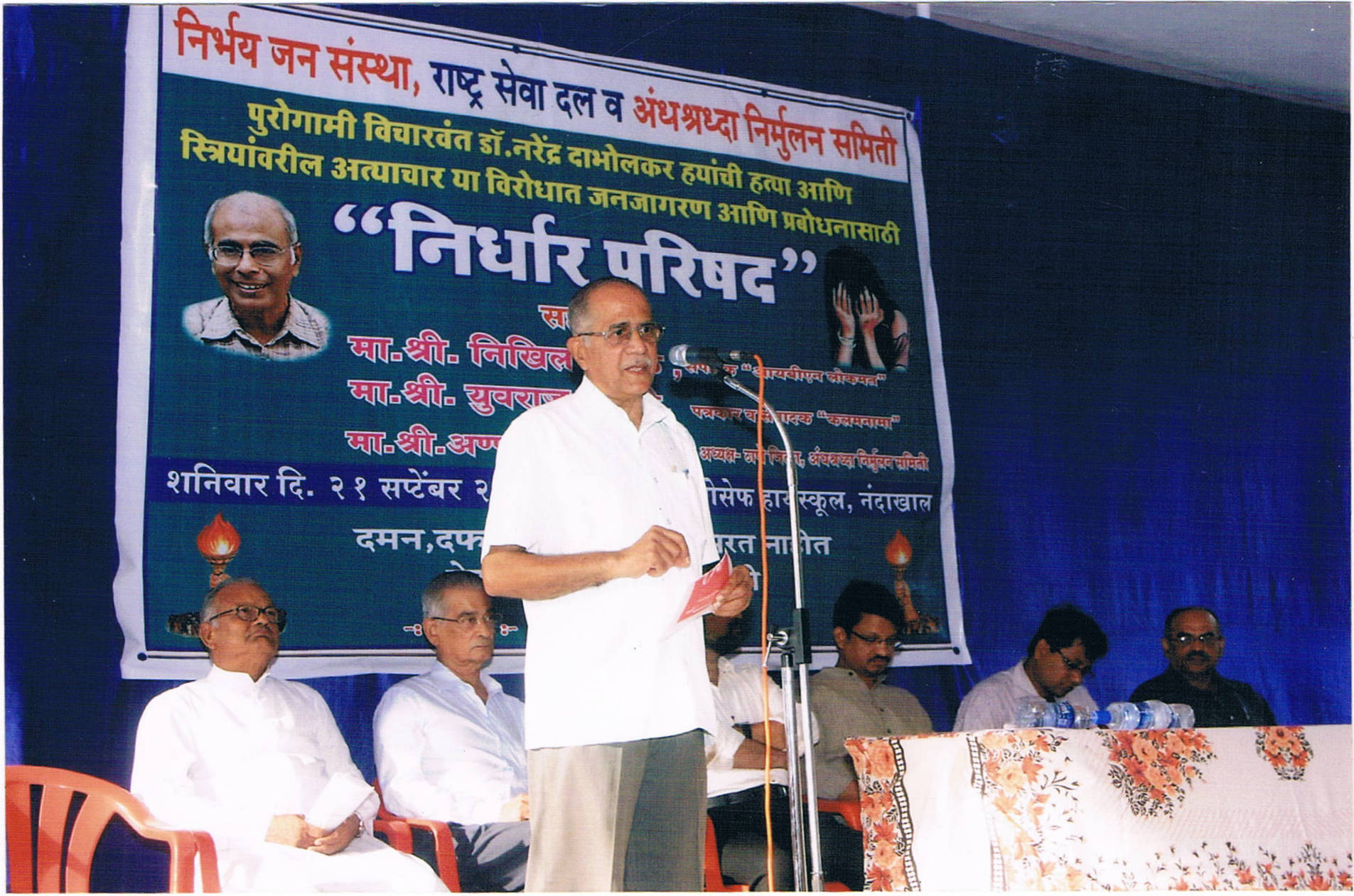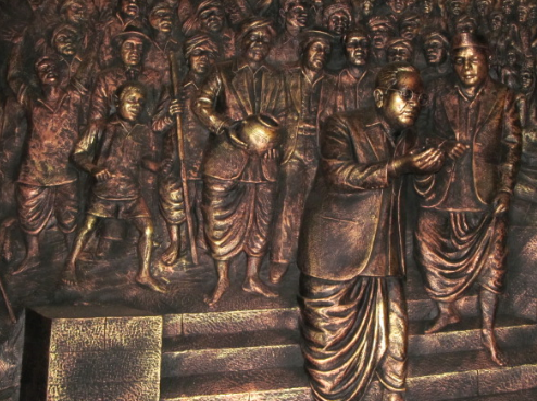Maharastra Becomes India’s First State to Criminalise Social Boycott. Here’s What That Means.
Social ostracism and boycott has been prevalent for centuries. Will this Act bring about a positive change?

Kavita Meghwal, a 19-year-old, and her family have been forced out of their village, and they have been living as outcasts for over a year now, all because Kavita decided to marry the man of her choice.
The panchayat that excommunicated her has remained unmoved in its stand despite many appeals. At one point, the panchayat set an unrealistic and unreasonable condition for them – pay Rs. 5 lakh to be accepted back into the village. However, even complaints made to the police were of no avail. And this is India in 2017.
Various reports suggest that social ostracism is still rampant and being used to put pressure on communities to live within the prescribed guidelines laid down by the panchayats.

Photo Source: Wikimedia Commons
In a bid to put an end to this social evil, on July 4, 2017 Maharastra became the first state in India to introduce the Maharashtra Prohibition of People from Social Boycott Act, 2016, which prohibits social boycott of a person or a group of people by panchayats. This Act is the culmination of the five-year crusade by anti-superstition activists. Dr. Narendra Dabholkar, a medical doctor, turned to social work more than two decades ago. In 1989, he set up the Maharashtra Andhrashraddha Nirmoolan Samiti to help eradicate superstition. His statewide movement targeted godmen and superstitious practices.
He paid for his beliefs with his life when was shot dead by two motorists in August 2013.

Photo Source: Wikimedia Commons
Historically, the strong prevalence of the para-legal systems of village panchayats and caste councils have worked effectively as judicial-cum-social institutions in our vast country.
However, with changing times, the effectiveness of these bodies has decreased and their form mutated. While the development of the legal system in India rendered the verdicts and edicts of these bodies legally non-binding, these councils, run by the power centers in their respective domains, have used social pressure as their strategy to remain relevant and feared. The fear of excommunication and social boycott weigh heavily on those who proscribe these village councils.
You may also like: B R Ambedkar: 10 Facts You Probably Don’t Know About The Father of the Indian Constitution
Social ostracism has continued over the centuries. During the mid-19th century, intra-community battles over access to public goods under the colonial state had begun. In those days, the “untouchable castes” were not allowed access to public spaces like schools, temples etc. on the ground that caste Hindus did not wish to “associate” with the “untouchables”. After sustained protests lasting a few decades, towards the end of the 19th century, Dalit students were allowed to attend public schools, but were directed to sit separately in a verandah outside the classroom. They were also barred from accessing the common water supply.
As the struggle continued it caught on in intensity and it was B.R. Ambedkar’s famous Mahad satyagraha that brought some respite to the community. He also simultaneously launched a movement for entry into public temples, basing his claims on the right to an equal standing within the community.
As he famously argued, “the issue is not entry, but equality.”

Photo Source: Wikimedia Commons
While this was one dimension of social boycott, another aspect of this evil is the use of excommunication and ostracism as tools of deterrence and control, within religious and caste-based communities. A few years after India attained independence in 1949, The State of Bombay passed a law called the Bombay Prevention of Excommunication Act, which outlawed the practice of excommunication within religious communities. The constitutionality of this Act was challenged by the head of the Dawoodi Bohra community, who argued that by curtailing the powers of excommunication, the law interfered with their religious freedom.
However, in 1962, a divided Supreme Court struck down the Act. The judges in the majority held that the practice of excommunication was an essential tool for maintaining community discipline and cohesiveness, and consequently, was protected by Article 26(b) of the Constitution, which guaranteed to all religious denominations the right to manage their own affairs in matters of religion.
Avinash Patil, State Executive President, Maharastra Andhashraddha Nirmoolan Samiti, said, “This is the first time an Act of this nature has been introduced anywhere in India. Post independence and even after accepting our Constitution, parallel judicial systems continue to exist and there has been no mechanism to take note of this. We are so caste driven that this Act is one that will break all barriers. Caste should not and must not be a reason to put pressure of any kind on anyone. The law of the land is supreme and cannot be taken into the hands of anyone or any group. We are hopeful that other states will also follow suit.”
The salient features of the Act are:
1. Maharastra becomes the first state to implement this Act
2. The Act empowers governments to designate ‘Social Boycott Prohibition Officers’ to take legal action against caste panchayats
3. Trial in such cases must be completed within six months from the date of filing the charge sheet
4. Social boycott is not just prohibited but will be seen as an offence under the Act
5. Whoever is found guilty of engaging in social boycott or causing it shall be punished with imprisonment of either seven years, fine of upto five lakhs or both.
6. Aiding and abetting social boycott will also be seen as an offence under the Act and will attract a punishment of upto three years, fine of upto three lakhs or both.
7. The victim can file a complaint either with the police or directly with the Magistrate. In cases where the Magistrate feels the need of protecting the victim, he may direct the police to provide the same
8. Under the Act, the fine imposed can be kept aside in whole or part towards compensation for the victim
9. The burden of proof in such cases will lie solely on the accused
While this certainly is a welcome move by the Fadnavis Government, one needs to wait and watch the effect it has on communities that have been thriving on the power and control they yield. The devil, as always, lies in its implementation.
Like this story? Or have something to share?
Write to us: [email protected]
Connect with us on Facebook and Twitter.
NEW: Click here to get positive news on WhatsApp!
If you found our stories insightful, informative, or even just enjoyable, we invite you to consider making a voluntary payment to support the work we do at The Better India. Your contribution helps us continue producing quality content that educates, inspires, and drives positive change.
Choose one of the payment options below for your contribution-
By paying for the stories you value, you directly contribute to sustaining our efforts focused on making a difference in the world. Together, let’s ensure that impactful stories continue to be told and shared, enriching lives and communities alike.
Thank you for your support. Here are some frequently asked questions you might find helpful to know why you are contributing?


This story made me
-
97
-
121
-
89
-
167













